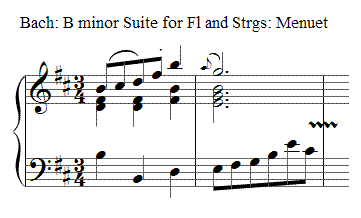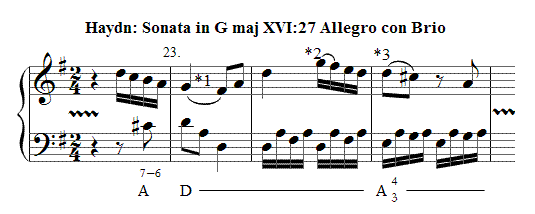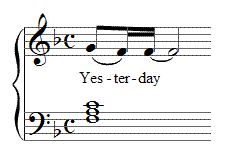APPENDIX A: VOICE LEADING OVERVIEW
The Appoggiatura
During the period of strict counterpoint in the 16th century, discords were only allowed if they were prepared and resolved in the ways described in the previous sections. The only discord normally allowed on the strong beat was the suspension. There the discord is prepared by the note being tied across from a weak to a strong beat and resolved onto the next weak beat. See Syncopation. However, a period of relaxation of the rules of voice leading followed which included experimentation with unprepared discords. The most important of these is called the appoggiatura.
The appoggiatura started as a decorative note which displaced the first part of a note of a melody. The appoggiatura occurred on the strong beat of the bar and could be either dissonant or consonant. In either case, the appoggiatura resolved (upwards or downwards) onto a consonance but unlike the suspension did not require to be prepared or tied from a previous note. In order to overcome the earlier rule that all discords had to be prepared, this note was originally shown as an ornament but later was written out in full. The following example shows the appoggiatura written as an ornament:

The appoggiatura is not a short ornament. It usually takes up a full half of the length of the note that it resolves onto. If the note resolves onto a note that is three beats long then it takes up a third or two thirds of the length of the note. The appoggiatura is usually connected with the main harmony note by a slur and is normally played with a small degree of emphasis. In the above example, the note A forms a discord with the underlying E minor chord but resolves by slurring onto the consonant G, usually taking up a third of the length of the G note.
The following example from Haydn shows appoggiaturas at *1, *2 and *3. These are written out in full as is the normal practice in the classical period. Their identity as elaborating notes is given away by the presence of the slurs.

There is no requirement for an appoggiatura to be approached in any particular way. In this example, each of the appoggiaturas is approached in a different way. The appoggiatura at *2 is an example of an appoggiatura that is approached by leap, so that it is clearly an unprepared discord. It is of equal rhythmic length to its resolution and it is tied to its resolution (F#). In understanding this example it is important to note that the left hand chord is arpeggiated so we have to understand that the G resolves as a 4th from the bass D to a 3rd from the bass D. This is because the arpeggiation in the bass is just another example of voice leading elaboration of the underlying D major chord so that the D bass is in effect throughout the bar.
The appoggiatura at *1 is approached by step but is still an appoggiatura, the G, an interval of a 4th from the bass, resolves onto the consonant F#, an interval of a 3rd from the bass. At the same time the bass undergoes voice leading elaboration in the form of arpeggiation. Here the appoggiatura is twice the length of its resolution.
The appoggiatura at *3 is possibly more difficult to understand. It is a prepared appoggiatura as the D is present in the previous chord, however, because the two D's are not tied this cannot correctly be called a suspension. The other potential complication in understanding this appoggiatura is that, whilst the appoggiatura forms a dissonant 7th with the bass, at the time of resolution to a C# the bass has moved on, but in fact the bass is just an arpeggiation of the dominant chord. The G in the bass needs to be understood as either an auxiliary note or as an arpeggiation of an essential seventh to the dominant chord (see later for the unprepared dominant 7th chord.) The resolution, in effect, forms a consonant 3rd with the second A in the bass and a consonant 6th with E which is effective throughout the bar. Thus the example shows three possible ways of preparing the appoggiatura but these are all are resolved in a similar way.
Because of the length of the appoggiatura, in relation to its resolution, and because of the way it is used, the appoggiatura is arguably a constituent of voice leading rather than an ornament, although it was initially treated as the latter.
It is possible to combine appoggiaturas, which move in 3rds or 6ths, sometimes forming whole new chords. See Appoggiatura Chord. The most important example of the double appoggiatura chord is the Cadential 6 4 chord. See next section for more information on that.
Appoggiaturas became an important voice leading device in all music after the 16th century. The Lennon and McCartney Song Yesterday starts with a downward appoggiatura on the first word of the song:

Next Topic: The Double Appoggiatura (Cadential 6 4 Chord)

